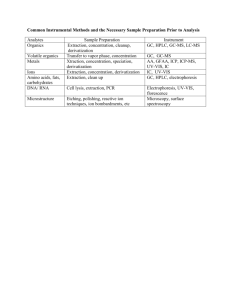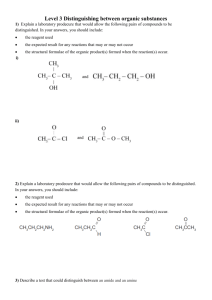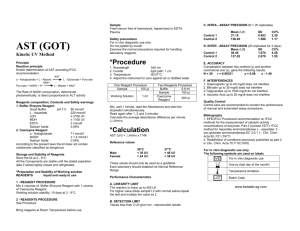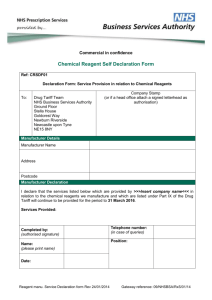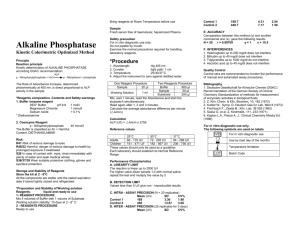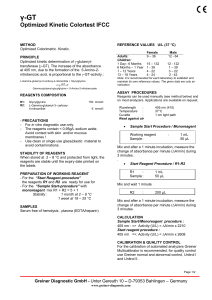2. Reagent for UV
advertisement
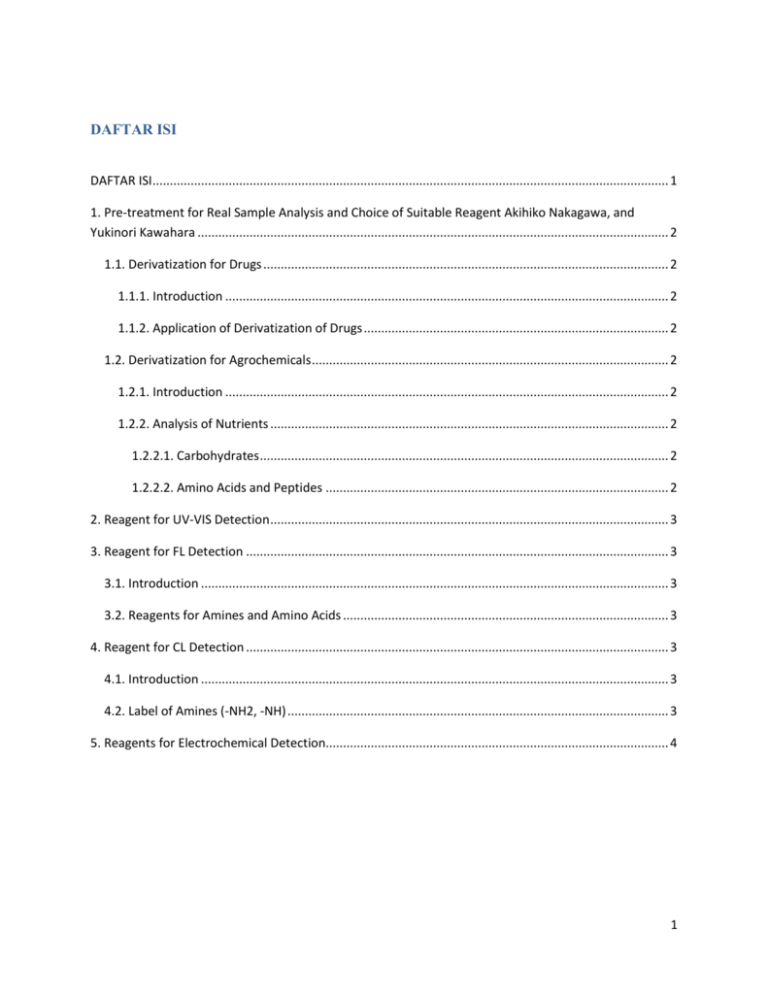
DAFTAR ISI DAFTAR ISI..................................................................................................................................................... 1 1. Pre-treatment for Real Sample Analysis and Choice of Suitable Reagent Akihiko Nakagawa, and Yukinori Kawahara ........................................................................................................................................ 2 1.1. Derivatization for Drugs ..................................................................................................................... 2 1.1.1. Introduction ................................................................................................................................ 2 1.1.2. Application of Derivatization of Drugs ........................................................................................ 2 1.2. Derivatization for Agrochemicals ....................................................................................................... 2 1.2.1. Introduction ................................................................................................................................ 2 1.2.2. Analysis of Nutrients ................................................................................................................... 2 1.2.2.1. Carbohydrates ...................................................................................................................... 2 1.2.2.2. Amino Acids and Peptides ................................................................................................... 2 2. Reagent for UV-VIS Detection ................................................................................................................... 3 3. Reagent for FL Detection .......................................................................................................................... 3 3.1. Introduction ....................................................................................................................................... 3 3.2. Reagents for Amines and Amino Acids .............................................................................................. 3 4. Reagent for CL Detection .......................................................................................................................... 3 4.1. Introduction ....................................................................................................................................... 3 4.2. Label of Amines (-NH2, -NH) .............................................................................................................. 3 5. Reagents for Electrochemical Detection................................................................................................... 4 1 1. Pre-treatment for Real Sample Analysis and Choice of Suitable Reagent Akihiko Nakagawa, and Yukinori Kawahara 1.1. Derivatization for Drugs 1.1.1. Introduction Drug analysis is mainly divided into three fields; materials, formulations and bioanalysis of specimens obtained in vitro and in vivo. The former two are controlled by regulations such as UPS in the USA, and the physico-chemical properties of drugs are summarized in a series of books entitled 'Analytical Profiles of Drug Substances', published periodically by Academic Press Inc. from 1972. In this section, methods for derivatization for drugs, in order to monitor their levels in biological samples, are described. 1.1.2. Application of Derivatization of Drugs For HPLC separation of DNS-ED-derivatized pravastatin, a column-switching technique was used to remove excess reagents and by-products. The HPLC system was described elsewhere [5]. In this case, a combination of two reversed-phase columns of different lipophilicity were employed: A C4 column was used as a preseparation column (first column) to delete the major peaks derived from the reagents and the plasma components, and a fraction containing derivatized pravastatin was introduced into the analytical C18 column (second column). A comparison between the chromatograms obtained with the ODS column 30/09/2003 1.2. Derivatization for Agrochemicals 1.2.1. Introduction Chemical compounds found in foods can be divided into two categories: essential nutrients that maintain human lives and substances which have unfavorable effects on man. The former includes saccharides, fats, amino acids, proteins, vitamins, and minerals. The latter contains environmental hazardous compounds such as organic mercury and PCB. 1.2.2. Analysis of Nutrients 1.2.2.1. Carbohydrates Carbohydrates are structurally classified into monosaccharides, oligosaccharides and polysaccharides. Monosaccharides and some oligosaccharides taste sweet. Compounds whose aldehyde group in aldose is substituted by primary alcohol are called sugar alcohol. This chapter describes the analysis of carbohydrates including sugar alcohol. 1.2.2.2. Amino Acids and Peptides Proteins are the main constituents of organisms, and about 20 amino acids build polypeptide chains with peptide bonding. Molecular weights of proteins range from 4000 (protamine etc.) to some ten millions (virus proteins etc.). 2 2. Reagent for UV-VIS Detection Whenever a new or a more sensitive and selective method has been developed for the detection and determination of biologically important compounds, drugs or their metabolites, biopolymers, and also environmental pollutants, important scientific knowledge has evolved to a greater or lesser extent. In the 1970s and 1980s, various derivatization methods for ultraviolet and visible light (UV-VIS) absorption detection have been developed [1-5] for high-performance liquid chromatography (HPLC), and many of the fundamental UV-VIS derivatizing reagents 30/09/2003 3. Reagent for FL Detection 3.1. Introduction High-performance liquid chromatography (HPLC) has been one of the most widely used of the effective separation methods, Capillary electrophoresis (CE) is rapidly becoming an accepted routine analytical technique, characterized by short run times and high efficiencies. Of the various detection methods used in HPLC and CE, fluorescence detection has been frequently utilized for the determination of trace levels of bioactive compounds in complicated matrices such as biological and environmental samples, owing to its high selectivity and sensitivity. However, most biologically and environmentally important substances are weakly fluorescent or nonfluorescent. Thus, various reagents have been developed for the fluorescence detection of their substances in HPLC and CE. 3.2. Reagents for Amines and Amino Acids The reagents utilized for fluorescence detection are divided into two groups: 'fluorogenic reagent' and 'fluorescence labeling reagent'. The fluorogenic reagents are generally non-fluorescent and react with target compounds to form conjugatedring molecules, resulting in the generation of fluorescence. The fluorescence labeling reagents are composed of a highly fluorescent aromatic moiety (fluorophore) and a reactive group, and the reactive group attaches to an analyte to give a fluorescent derivative. 4. Reagent for CL Detection 4.1. Introduction In the analysis of environmental contaminants using chromatography, the analysis of GC methods which are superior to LC methods in separation characteristics and sensitivity have, together with the rapid popularization of GC/MS, been applied far more widely than in the analysis of bio-chemicals due to the applicability of many of the analytes to GC. 4.2. Label of Amines (-NH2, -NH) The detection and determination of amines are concerned not only with biochemical but also industrial analysis. Thus various derivatization reagents for the chromatographic determination of primary and secondary amines as well as tertiary amines, are available. In many biologically important compounds, an amino groups exists as amino acids and polyamines. When HPLC or CE analysis of these amino compounds with direct UV-VIS detection is difficult because of the 3 weak UV-VIS absorption of the compounds, derivatization of amines with a reagent having a strong UV-VIS absorbing structure is one of the considerable methods to choose from. 5. Reagents for Electrochemical Detection Electroanalytical methods are categorized by their mode of measurement into amperometric (measurement of current), potentiometric (measurement of voltage), and conductimetric (measurement of conductivity) methods. This chapter deals with amperometric electroanalysis in flowing streams [1-3]. The major advantages of amperometric detection over classical spectroscopic measurements are its high selectivity, low detection limits, and the simplicity of the instrument. 4
